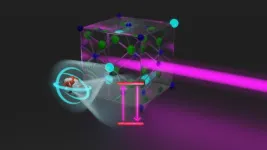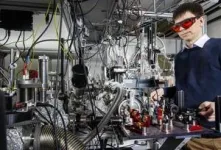(Press-News.org) Physicists have been hoping for this moment for a long time: for many years, scientists all around the world have been searching for a very specific state of thorium atomic nuclei that promises revolutionary technological applications. It could be used, for example, to build an nuclear clock that could measure time more precisely than the best atomic clocks available today. It could also be used to answer completely new fundamental questions in physics - for example, the question of whether the constants of nature are actually constant or whether they change in space and time.
Now this hope has come true: the long-sought thorium transition has been found, its energy is now known exactly. For the first time, it has been possible to use a laser to transfer an atomic nucleus into a state of higher energy and then precisely track its return to its original state. This makes it possible to combine two areas of physics that previously had little to do with each other: classical quantum physics and nuclear physics. A crucial prerequisite for this success was the development of special thorium-containing crystals. A research team led by Prof. Thorsten Schumm from TU Wien (Vienna) has now published this success together with a team from the National Metrology Institute Braunschweig (PTB) in the journal "Physical Review Letters".
Switching quantum states
Manipulating atoms or molecules with lasers is commonplace today: if the wavelength of the laser is chosen exactly right, atoms or molecules can be switched from one state to another. In this way, the energies of atoms or molecules can be measured very precisely. Many precision measurement techniques are based on this, such as today's atomic clocks, but also chemical analysis methods. Lasers are also often used in quantum computers to store information in atoms or molecules.
For a long time, however, it seemed impossible to apply these techniques to atomic nuclei. "Atomic nuclei can also switch between different quantum states. However, it usually takes much more energy to change an atomic nucleus from one state to another – at least a thousand times the energy of electrons in an atom or a molecule," says Thorsten Schumm. "This is why normally atomic nuclei cannot be manipulated with lasers. The energy of the photons is simply not enough."
This is unfortunate, because atomic nuclei are actually the perfect quantum objects for precision measurements: They are much smaller than atoms and molecules and are therefore much less susceptible to external disturbances, such as electromagnetic fields. In principle, they would therefore allow measurements with unprecedented accuracy.
The needle in the haystack
Since the 1970s, there has been speculation that there might be a special atomic nucleus which, unlike other nuclei, could perhaps be manipulated with a laser, namely thorium-229. This nucleus has two very closely adjacent energy states – so closely adjacent that a laser should in principle be sufficient to change the state of the atomic nucleus.
For a long time, however, there was only indirect evidence of the existence of this transition. "The problem is that you have to know the energy of the transition extremely precisely in order to be able to induce the transition with a laser beam," says Thorsten Schumm. "Knowing the energy of this transition to within one electron volt is of little use, if you have to hit the right energy with a precision of one millionth of an electron volt in order to detect the transition.” It is like looking for a needle in a haystack – or trying to find a small treasure chest buried on a kilometer-long island.
The thorium crystal trick
Some research groups have tried to study thorium nuclei by holding them individually in place in electromagnetic traps. However, Thorsten Schumm and his team chose a completely different technique. "We developed crystals in which large numbers of thorium atoms are incorporated," explains Fabian Schaden, who developed the crystals in Vienna and measured them together with the PTB team. "Although this is technically quite complex, it has the advantage that we can not only study individual thorium nuclei in this way but can hit approximately ten to the power of seventeen thorium nuclei simultaneously with the laser – about a million times more than there are stars in our galaxy." The large number of thorium nuclei amplifies the effect, shortens the required measurement time and increases the probability of actually finding the energy transition.
On November 21, 2023, the team was finally successful: the correct energy of the thorium transition was hit exactly, the thorium nuclei delivered a clear signal for the first time. The laser beam had actually switched their state. After careful examination and evaluation of the data, the result has now been published.
"For us, this is a dream coming true," says Thorsten Schumm. Since 2009, Schumm had focused his research entirely on the search for the thorium transition. His group as well as competing teams from all over the world have repeatedly achieved important partial successes in recent years. "Of course we are delighted that we are now the ones who can present the crucial breakthrough: The first targeted laser excitation of an atomic nucleus," says Schumm.
The dream of the atomic nucleus clock
This marks the start of a new exciting era of research: now that the team knows how to excite the thorium state, this technology can be used for precision measurements. "From the very beginning, building an atomic clock was an important long-term goal," says Thorsten Schumm. "Similar to how a pendulum clock uses the swinging of the pendulum as a timer, the oscillation of the light that excites the thorium transition could be used as a timer for a new type of clock that would be significantly more accurate than the best atomic clocks available today."
But it is not just time that could be measured much more precisely in this way than before. For example, the Earth's gravitational field could be analyzed so precisely that it could provide indications of mineral resources or earthquakes. The measurement method could also be used to get to the bottom of fundamental mysteries of physics: Are the constants of nature really constant? Or can tiny changes perhaps be measured over time? "Our measuring method is just the beginning," says Thorsten Schumm. "We cannot yet predict what results we will achieve with it. It will certainly be very exciting."
END
Atomic nucleus excited with laser: a breakthrough after decades
The "thorium transition", which has been sought after for decades, has now been excited for the first time with lasers. This paves the way for revolutionary high precision technologies, including nuclear clocks
2024-04-29
ELSE PRESS RELEASES FROM THIS DATE:
Losing keys and everyday items ‘not always sign of poor memory’
2024-04-29
The mysteries of how memory works are explained in a new book that suggests anyone can boost their powers of recall – and that losing your keys is normal.
Dr Megan Sumeracki and Dr Althea Need Kaminske say storing and retrieving information is far more complex than people think. Extremes of memory such as photographic or savant are also very rare despite their regular portrayal in films.
Their new book The Psychology of Memory outlines simple recollection-boosting techniques to improve learning – or to help remember names and numbers.
Forgetting is normal
The authors highlight how a degree ...
People with opioid use disorder less likely to receive palliative care at end of life
2024-04-29
Compared with people without opioid use disorder, those with opioid use disorder were less likely to receive palliative care in clinics and in their homes, and were dying at younger ages of causes other than opioid use, according to new research published in CMAJ (Canadian Medical Association Journal) https://www.cmaj.ca/lookup/doi/10.1503/cmaj.231419.
“The majority of conversations about the opioid crisis focus on the high number of opioid toxicity deaths. The unfortunate reality is that people with opioid use disorder ...
New Durham University study reveals mystery of decaying exoplanet orbits
2024-04-29
-With images-
A new study led by researchers at Durham University has uncovered a novel mechanism that could solve a long-standing mystery about decaying planetary orbits around stars like our Sun.
The study, published in The Astrophysical Journal Letters, proposes that stellar magnetic fields play a crucial role in dissipating the gravitational tides responsible for the orbital decay of ‘hot Jupiter’ exoplanets.
Hot Jupiters are massive, gaseous planets similar to Jupiter that orbit extraordinarily close to their parent stars, taking only a few days to complete ...
The threat of polio paralysis may have disappeared, but enterovirus paralysis is just as dangerous and surveillance and testing systems are desperately needed
2024-04-29
Consistently high vaccination rates and global health surveillance programmes have helped eliminate poliomyelitis (polio) in almost all countries of the world, except Afghanistan and Pakistan. Yet non-polio enteroviruses can also lead to the same devastating symptoms of ‘acute flaccid paralysis’ (AFP), but the world is lacking formal surveillance systems to trace and control these viruses with paralytic potential.
In a presentation at this year’s ESCMID Global Congress (formerly ECCMID) (Barcelona 27-30 April), Prof Thea Kølsen Fischer, Nordsjællands Hospital & University of Copenhagen, Denmark will highlight the continuous dangers that ...
Study shows ChatGPT failed when challenging ESCMID guideline for treating brain abscesses
2024-04-29
With artificial intelligence (AI) poised to become a fundamental part of clinical research and decision making, many still question the accuracy of ChatGPT, a sophisticated AI language model, to support complex diagnostic and treatment processes.
Now a new study, being presented at this year’s ESCMID Global Congress (formerly ECCMID) in Barcelona, Spain (27-30 April), which pitted ChatGPT against the ESCMID guideline for the management of brain abscesses, found that while ChatGPT seems able to give recommendations on key questions about diagnosis and treatment in most cases, some of the AI model’s ...
Study finds resistance to critically important antibiotics in uncooked meat sold for human and animal consumption
2024-04-29
**Note: the release below is from the ESCMID Global Congress (formerly ECCMID, Barcelona, Spain, 27-30 April). Please credit the congress if you use this story**
New research presented at the ESCMID Global Congress (formerly ECCMID) in Barcelona, Spain (27-30 April) has found substantial levels of resistance to critically important antibiotics in meat sold for human and animal consumption. The study is by Dr Jordan Sealey, Professor Matthew Avison and colleagues from the University of Bristol, UK.
Meat sold for consumption by humans and companion animals in the UK is regulated by the UK Government Food Standards Agency (FSA) to ensure it falls within bacterial limits deemed ...
Global cervical cancer vaccine roll-out shows it to be very effective in reducing cervical cancer and other HPV-related disease, but huge variations between countries in coverage
2024-04-28
With the creation of safe and efficacious vaccines to target human papillomavirus in the first decade of this century, WHO has an ambitious target to lower cervical cancer incidence (mostly caused by HPV) and mortality by 30% by 2030, meaning each country has a target of vaccinating 90% of girls by age 15, 70% of women receiving a high precision screening test at least at age 35 and 45 years of age, and 90% of all women requiring treatment at any age to receive it. The targets are aspirational and as yet, it appears no country has been ...
Negativity about vaccines surged on Twitter after COVID-19 jabs become available
2024-04-28
It’s time to take a new approach to addressing negative messaging about vaccines, including avoiding the use of the term “anti-vaxxers”, say the researchers.
**ECCMID has now changed name to ESCMID Global, please credit ESCMID Global Congress in all future stories**
There was a marked increase in negativity about vaccines on Twitter after COVID-19 vaccines became available, the ESCMID Global Congress (formerly ECCMID) in Barcelona, Spain (27-30 April) will hear.
The analysis also found that spikes in the number of negative tweets coincided with announcements ...
Global measles cases almost double in a year
2024-04-28
Provisional global total of 321,582 cases for 2023 is almost double (88% higher) than 2022 figure of 171,153
**ECCMID has now changed name to ESCMID Global, please credit ESCMID Global Congress in all future stories**
Measles outbreaks are still occurring and in some cases increasing, among a wide variety of countries, raising concerns of an acceleration similar to just before the COVID pandemic. Dr Patrick O’Connor, of WHO Headquarters, Geneva, Switzerland will give an overview of the global measles situation at this year’s ...
Lower dose of mpox vaccine is safe and generates six-week antibody response equivalent to standard regimen
2024-04-27
WHAT:
A dose-sparing intradermal mpox vaccination regimen was safe and generated an antibody response equivalent to that induced by the standard regimen at six weeks (two weeks after the second dose), according to findings presented today at the European Society of Clinical Microbiology and Infectious Diseases Global Congress in Barcelona. The results suggest that antibody responses contributed to the effectiveness of dose-sparing mpox vaccine regimens used during the 2022 U.S. outbreak.
The ...
LAST 30 PRESS RELEASES:
Air pollution exposure and birth weight
Obstructive sleep apnea risk and mental health conditions among older adults
How talking slows eye movements behind the wheel
The Ceramic Society of Japan’s Oxoate Ceramics Research Association launches new international book project
Heart-brain connection: international study reveals the role of the vagus nerve in keeping the heart young
Researchers identify Rb1 as a predictive biomarker for a new therapeutic strategy in some breast cancers
Survey reveals ethical gaps slowing AI adoption in pediatric surgery
Stimulant ADHD medications work differently than thought
AI overestimates how smart people are, according to HSE economists
HSE researchers create genome-wide map of quadruplexes
Scientists boost cell "powerhouses" to burn more calories
Automatic label checking: The missing step in making reliable medical AI
Low daily alcohol intake linked to 50% heightened mouth cancer risk in India
American Meteorological Society announces Rick Spinrad as 2026 President-Elect
Biomass-based carbon capture spotlighted in newly released global climate webinar recording
Illuminating invisible nano pollutants: advanced bioimaging tracks the full journey of emerging nanoscale contaminants in living systems
How does age affect recovery from spinal cord injury?
Novel AI tool offers prognosis for patients with head and neck cancer
Fathers’ microplastic exposure tied to their children’s metabolic problems
Research validates laboratory model for studying high-grade serous ovarian cancer
SIR 2026 delivers transformative breakthroughs in minimally invasive medicine to improve patient care
Stem Cell Reports most downloaded papers of 2025 highlight the breadth and impact of stem cell research
Oxford-led study estimates NHS spends around 3% of its primary and secondary care budget on the health impacts of heat and cold in England
A researcher’s long quest leads to a smart composite breakthrough
Urban wild bees act as “microbial sensors” of city health.
New study finds where you live affects recovery after a hip fracture
Forecasting the impact of fully automated vehicle adoption on US road traffic injuries
Alcohol-related hospitalizations from 2016 to 2022
Semaglutide and hospitalizations in patients with obesity and established cardiovascular disease
Researchers ‘listen in’ to embryo-mother interactions during implantation using a culture system replicating the womb lining
[Press-News.org] Atomic nucleus excited with laser: a breakthrough after decadesThe "thorium transition", which has been sought after for decades, has now been excited for the first time with lasers. This paves the way for revolutionary high precision technologies, including nuclear clocks



